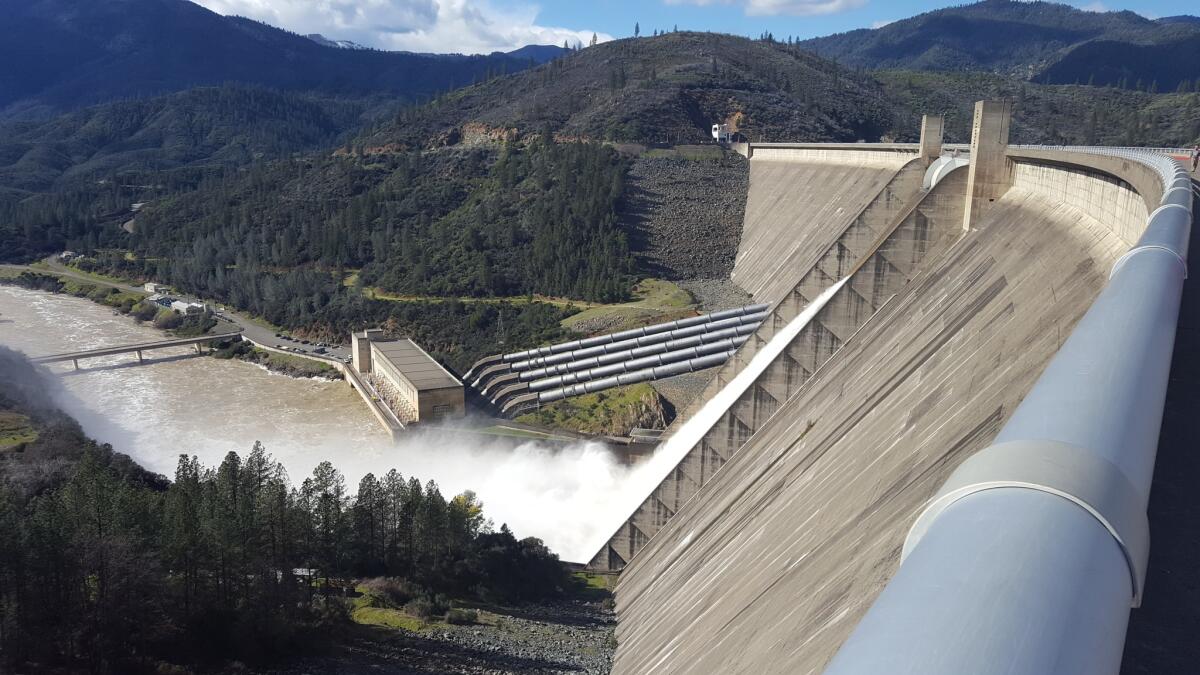Hydro, wind and solar make inroads in California’s electric grid

- Share via
Wetter weather and continued growth in renewable energy sources resulted in some big changes in electricity generation in California in 2016, according to numbers recently released by the California Energy Commission.
Natural gas still accounted for the largest single share of in-state power generation but the amount deployed dropped 10% last year.
The difference was largely replaced by electricity produced by large hydro facilities — home to reservoirs that started to fill up at the end of 2016 as one of the wettest winters on record began — and production from wind and solar, which each posted double-digit growth.
Natural gas has quickly developed as a dominant fuel, not just in California but across the country. Supplies have grown because of enhanced production techniques, and that has resulted in lower prices.
In 2015, natural gas accounted for just under 60% of in-state generation, while large hydro facilities — hamstrung by a years-long drought — accounted for less than 6%.
But rain and a vastly improved snowpack in the Sierra Nevada resulted in a big gain for electricity from large hydroelectric sources, with large facilities more than doubling their share of in-state generation to 12.31%.
And that number is in good shape to hold up in 2017 because the wet weather across the state continued during the first few months of the year. In February, there were reports of snowpacks at more than 180% of normal and in early April, Gov. Jerry Brown declared the state’s drought had officially ended.
In general, when the runoff and snowmelt numbers are plentiful, California’s hydroelectricity is less expensive to buy than electricity generated by plants using natural gas-fired generation.
That, energy commission analyst Marc Pryor said, leads to an increase in hydroelectricity and a decrease in natural gas.
“It’s not a one-for-one,” Pryor said, “but it’s definitely noticeable.”
What’s also noticeable is the effect of renewable sources — solar and wind in particular.
Renewable energy in 2016 made up 27.9% of in-state electric generation, up from 24.5% the previous year.
That may not appear to be a big gain, but it’s nearly a three-fold increase from 10 years earlier.
Plus, compared to 2015, wind saw a 10.8% increase, and solar jumped 31.5%.
What’s more, the solar number across the state is actually higher than what’s reflected in the California Energy Commission data because the commission does not have a mechanism to track rooftop solar projects erected by homeowners and small businesses. The commission numbers account for solar systems that are 1-megawatt and larger.
“We’ve been talking about the growth of renewables, and it just keeps a steady drumbeat,” said commission spokesman Albert Lundeen. “Every year it continues to grow.”
Natural gas as a percentage of in-state generation dropped below the 59% mark in the CEC numbers for the first time since 2011.
The Aliso Canyon natural gas storage facility in the Los Angeles area remained offline throughout 2016, but Pryor said he did not think that contributed to the decline in natural gas generation. Aliso Canyon spewed more than 100,000 metric tons of methane into the air between October 2015 and February 2016, forcing the evacuation of 8,000 households in the Porter Ranch neighborhood.
Nuclear energy’s share of in-state generation remained steady, at 9.55%, virtually unchanged from 2015. However, Diablo Canyon is the only nuclear plant left in California, and its operator, Pacific Gas & Electric, has plans before the California Public Utility Commission to close the facility by 2025.
Before the San Onofre Nuclear Generating Station was taken offline in January 2012, nuclear power accounted for 15% to 18% of in-state generation. In its absence, natural gas helped fill the gap.
Nuclear power and large hydroelectricity aren’t counted in the CEC definition of renewable energy, but when they are added, California’s generation from sources that do not emit carbon dioxide accounted for 49.7% of total in-state generation in 2016. That’s up from 39.8% in 2015.
The amount of coal in California continues to drop, accounting for less than 0.2% of in-state electric generation.
According to the CEC, about 97% of coal-fired electricity was generated by power plants outside California — from states such as Utah, Oregon and New Mexico — and by 2026, the amount generated is expected to decline to zero.
Total California in-state electric generation
2016: 198,227 gigawatt-hours
2015: 196,195 gigawatt-hours
Source: California Energy Commission
Nikolewski writes for the San Diego Union-Tribune.
rob.nikolewski@sduniontribune.com
ALSO
Revised GOP healthcare bill would still leave millions without insurance, new report concludes
Amazon’s Treasure Truck is rolling out nationwide
Bakersfield votes to end controversial program that funds energy-efficiency upgrades for homes
More to Read
Inside the business of entertainment
The Wide Shot brings you news, analysis and insights on everything from streaming wars to production — and what it all means for the future.
You may occasionally receive promotional content from the Los Angeles Times.











